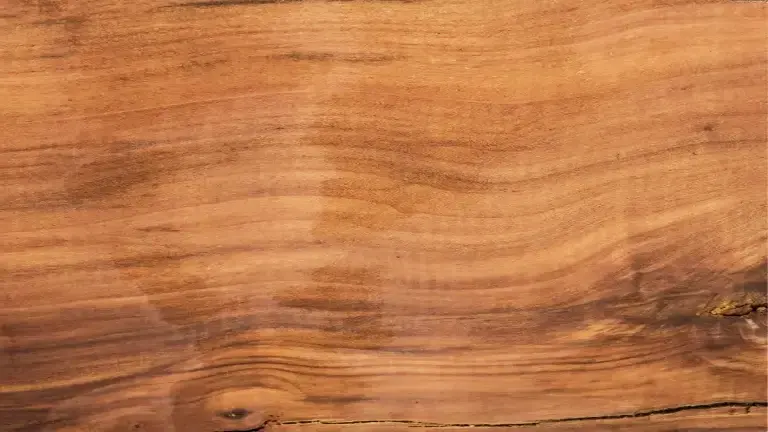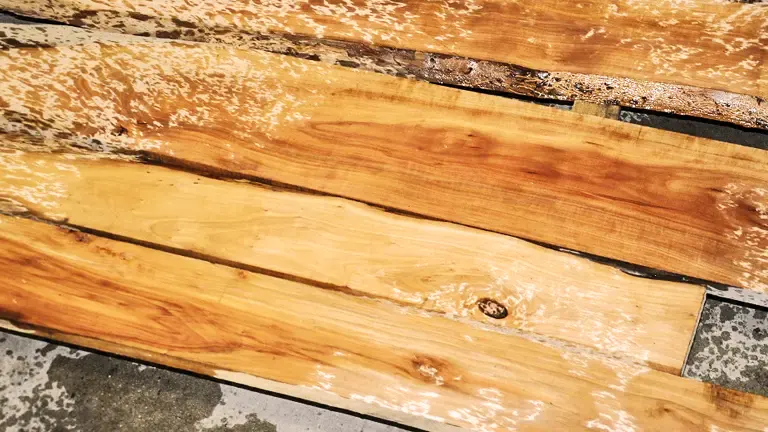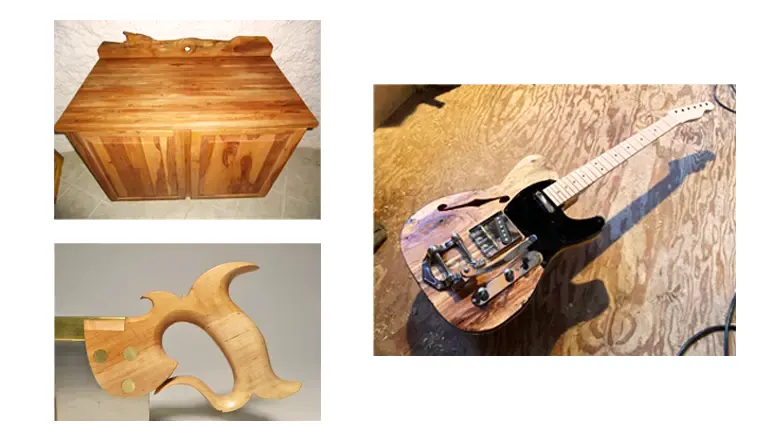Apple Lumber
- June 26, 2023
- 0 comment
Apple wood lumber is a unique and prized type of wood that, while not typically used for large-scale construction or furniture due to the relatively small size of apple trees, has a variety of specialized applications. It is often derived from old or non-productive fruit trees, contributing to its scarcity and often higher price points. The color of apple wood tends to range from light to reddish-brown, featuring a fine, straight grain that gives it an appealing visual texture. The wood is known for its density and overall strength, although this can make it somewhat challenging to work with as it has a tendency to dull cutting tools.

One of the distinctive characteristics of apple wood is its aromatic properties. When green, the wood emits a pleasant, distinctively fruity aroma which lends itself well to uses such as smoking chips for food preparation. Applewood has a moderate level of decay resistance and it’s not particularly prone to insect attack. However, like many kinds of wood, exposure to apple wood dust can potentially cause allergic reactions, including skin and eye irritation.
Due to the small size of the trees and the fact that they are primarily grown for their fruit, apple lumber isn’t commonly available on a commercial scale. However, it can be found in specialized applications such as fine furniture details, carving, tool handles, and, as previously mentioned, smoking chips for food. Despite its limited availability, the wood of the apple tree is considered a byproduct of the fruit industry, making it a potentially sustainable source of material for these specialized uses. Apple lumber brings with it a combination of aesthetic appeal, unique aromatic properties, and a dense, strong structure that makes it a sought-after choice for many woodworkers and craftsmen.
| Common Name(s) | Apple |
|---|---|
| Scientific Name | Malus spp. |
| Distribution | North America, Europe, Asia |
| Tree Size | 20-40 ft (6-12 m) tall |
| Average Dried Weight | 43 lbs/ft^3 (690 kg/m^3) |
| Specific Gravity | 0.69 |
| Janka Hardness | 1,450 lbf (6,440 N) |
| Modulus of Rupture | 13,600 lbf/in^2 (94 MPa) |
| Elastic Modulus | 1,700,000 lbf/in^2 (11.72 GPa) |
| Crushing Strength | 8,480 lbf/in^2 (58.4 MPa) |
| Shrinkage | Radial: 3.6%, Tangential: 7.7%, Volumetric: 12.2%, T/R Ratio: 2.1 |
Characteristics
Color/Appearance
Apple wood has a pale yellow to light reddish-brown color, which can darken slightly with age and exposure. It often exhibits attractive figuring, including subtle streaks and occasional spalting, adding visual interest to the wood’s appearance.

Grain/Texture
The grain of Apple wood is usually straight, though it can display irregular patterns. It has a fine to medium texture with a moderate natural luster, providing a smooth and refined surface when finished.
Rot Resistance
Apple wood is not naturally resistant to decay and is susceptible to fungal attacks and insect infestations. Proper treatment and finishing techniques are essential to enhance its durability and protect it from moisture-related issues.
Workability
Apple wood is generally easy to work with, as it saws, planes, and sands well. It has good turning properties and can be carved and shaped with precision. It may display some interlocked grain, which can cause slight tear out during machining.
Odor
Apple wood has a mild, pleasant scent when freshly cut, which can resemble the smell of apples.
Allergies/Toxicity
There are no known allergies or toxic reactions associated with Apple wood. However, as with any wood dust, proper dust control measures should be followed to minimize potential respiratory irritation.
Pricing/Availability
Apple wood is considered a specialty wood and may have limited availability in certain regions. Its pricing can vary depending on factors such as local availability, demand, and specific characteristics of the wood.
Sustainability
Apple wood is generally considered a sustainable choice for woodworking. It is often sourced from orchard removals, pruning operations, or reclaimed materials, reducing its environmental impact. Utilizing Apple wood provides an opportunity for repurposing and preventing waste.
Common Uses
- Turning – Apple wood is highly valued by woodturners for its workability and unique figure. It is often used to create bowls, vases, pens, and other turned objects. The fine grain and attractive color of Apple wood add visual interest to the finished turned pieces.
- Carving – Apple wood is a popular choice for carving due to its fine grain and ability to hold intricate details. It is commonly used in sculpting, relief carving, and ornamental carving projects. The wood’s natural beauty enhances the intricacies of the carved designs.
- Specialty Items – Apple wood is sought after for specialty woodworking projects. It’s attractive color and unique figure make it suitable for crafting small decorative objects, such as boxes, cutting boards, jewelry organizers, and coasters. Apple wood adds a touch of natural elegance to these specialty items.
- Furniture Accents – Apple wood can be utilized as accents in furniture making. It is often incorporated into drawer fronts, inlays, and decorative trim pieces, adding a visually appealing contrast to other wood species. The use of Apple wood accents can create eye-catching details in furniture design.
- Musical Instruments – Apple wood is occasionally used in the construction of musical instruments, particularly for parts that benefit from its unique tonal qualities and workability. It can be found in the crafting of instrument bodies, backs, sides, or soundboard components.
- Tool Handles – Due to its durability and appealing aesthetics, Apple wood is well-suited for making handles for tools. Its strength and resistance to wear make it a reliable choice for tool handles that require both functionality and visual appeal.

Frequently Asked Questions
- What is Apple Lumber (Malus spp.)?
Apple Lumber, scientifically known as Malus spp., refers to a group of apple tree species and varieties commonly grown for their wood, primarily used in woodworking and carpentry. - What are the typical uses of Apple Lumber?
Apple wood is often used for crafting furniture, cabinetry, flooring, and various decorative items. It’s valued for its attractive grain patterns and durability. - Is Apple Lumber a sustainable choice for woodworking?
Yes, Apple Lumber is considered a sustainable choice because apple trees are relatively fast-growing and widely cultivated. Additionally, apple orchards often replace older trees, making the wood readily available. - How does Apple Lumber compare to other hardwoods in terms of hardness and durability?
Apple wood is known for its moderate hardness and durability. It falls somewhere between softer woods like pine and harder woods like oak or cherry. It can withstand wear and tear but may require proper finishing and maintenance. - What are the color and grain patterns of Apple Lumber?
Apple wood typically has a light to medium reddish-brown color with distinctive, irregular grain patterns. It often features small knots and fine lines that contribute to its aesthetic appeal. - Is Apple Lumber suitable for outdoor projects or exposed to the elements?
Apple wood is not recommended for outdoor applications without proper treatment and finishing. It’s not naturally resistant to decay or insects, so it should be protected if used outdoors. - Can I find Apple Lumber at a local lumberyard or home improvement store?
Apple Lumber is less common than some other hardwoods, so it may not be readily available at all lumberyards or stores. You may need to seek out specialty wood suppliers or mills that carry it. - How should I care for and maintain Apple Lumber furniture or items?
To maintain the beauty of Apple Lumber items, regularly clean them with a damp cloth and mild wood cleaner. Protect them from excessive moisture and direct sunlight, and consider refinishing when needed. - Are there any potential health concerns associated with working with Apple Lumber?
While Apple Lumber is generally safe to work with, like other woods, it may produce dust when cut or sanded. It’s advisable to wear appropriate respiratory protection and practice good workshop ventilation. - Can I use Apple Lumber for culinary purposes, such as smoking or grilling food?
Yes, Apple wood is a popular choice for smoking and grilling food due to its pleasant, mild, and slightly sweet aroma. Make sure the wood is untreated and free of any harmful chemicals before using it for cooking.
We’re eager to hear from you! Feel free to share your personal experiences and thoughts about Apple Lumber in the comments section below. Your insights could be a valuable resource for fellow woodworkers looking to make informed decisions!


Leave your comment